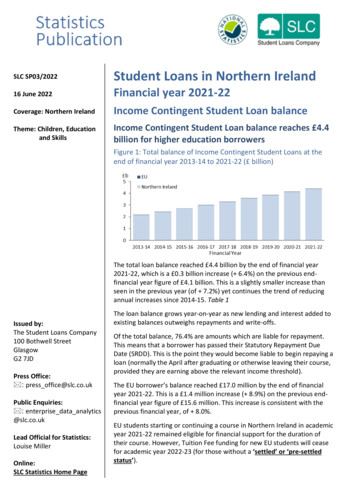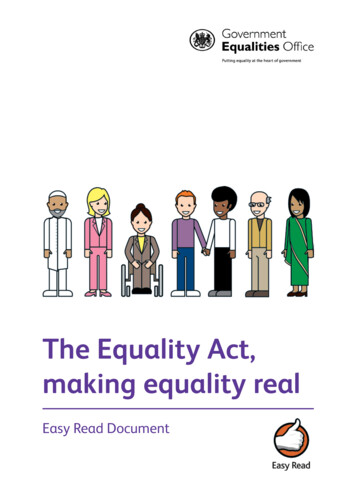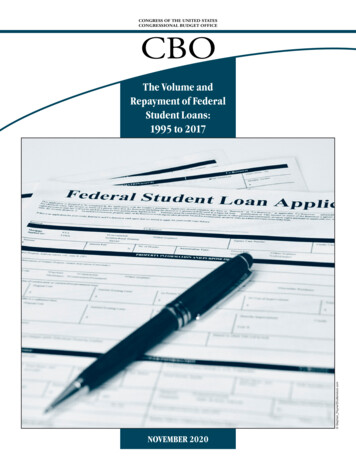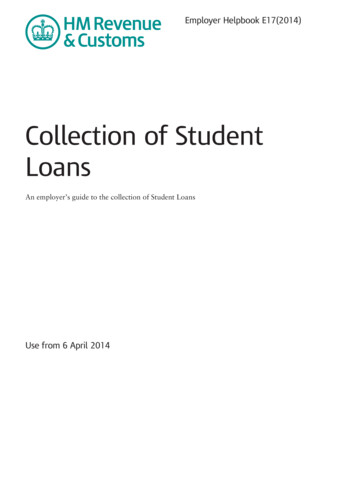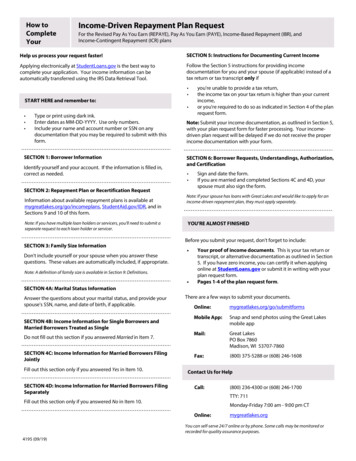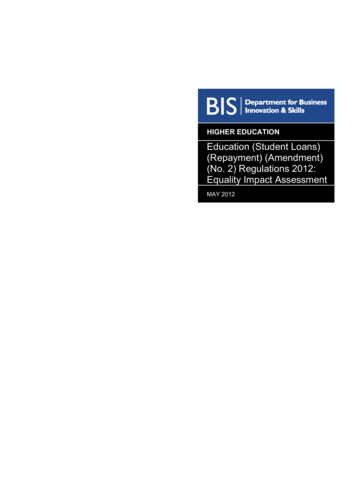
Transcription
HIGHER EDUCATIONEducation (Student Loans)(Repayment) (Amendment)(No. 2) Regulations 2012:Equality Impact AssessmentMAY 2012
Higher Education: Education (Student Loans) (Repayment) (Amendment) (No. 2) Regulations 2012: equality impact assessment2
Higher Education: Education (Student Loans) (Repayment) (Amendment) (No. 2) Regulations 2012: equality impact assessmentContentsContents .3Introduction.4Description of the policy .5Summary of analysis and impact.5Repayment threshold .8Write-off of the loan .9Real and Variable Interest rate provisions.9Interest rates and repayments from those who leave the UK to reside abroad.10New part-time students .10Credit balance – Interest Rate.11Annex 1 - Snapshot of participation in HE.12Annex 2 - Distributional Effects of the 12/13 student loan repayment system .17Monitoring and review .223
Higher Education: Education (Student Loans) (Repayment) (Amendment) (No. 2) Regulations 2012: equality impact assessmentIntroductionUnder the Equality Act 2010, the Department, as a public authority, is legally obliged to givedue regard to equality issues when making policy decisions - the public sector equality duty,also called the general equality duty. Analysing the effects on equality of these regulationsthrough developing an equality impact assessment is one method of ensuring that thinkingabout equality issues is built into the policy process, and informs Ministers’ decision making.BIS, as a public sector authority, must in the exercise of its functions, have due regard to theneed to: Eliminate unlawful discrimination, harassment and victimisation and other conductprohibited by the Act. Advance equality of opportunity between people who share a protected characteristic andthose who do not. Foster good relations between people who share a protected characteristic and thosewho do not.The general equality duty covers the following protected characteristics: age, disability, genderreassignment, pregnancy and maternity, race, religion or belief, sex and sexual orientation. Asdisadvantage in higher education is still apparent in connection to family income and economicstatus we will also look at the impact on individuals from lower income groups. We will use theterms protected and disadvantaged groups as well as protected characteristics. Protectedgroups is a reference to people with protected characteristics, and disadvantaged groups refersto low income groups.Any queries and comments about this equality impact assessment should be addressed to:Kathryn Symms, Department for Business, Innovation and Skills, Mowden Hall, StaindropRoad, Darlington, DL3 9BG, Kathryn.Symms@bis.gsi.gov.uk4
Higher Education: Education (Student Loans) (Repayment) (Amendment) (No. 2) Regulations 2012: equality impact assessmentDescription of the policy1. The intention of the Education (Student Loans) (Repayment) (Amendment) (No. 2)Regulations 2012 is to implement the new student finance arrangements for the repaymentof loans, for example the introduction of the 21,000 threshold in April 2016, real rates ofinterest from September 2012 and a 30 year write-off policy. The intended outcome is thatthe system is progressive and affordable. Those who gain most from their highereducation (HE) will pay the most due to the introduction of variable rates of interest oncethe student is due to start making repayments. As such the regulations will impact onthose students who take out loans under the new arrangements. The new repaymentarrangements are part of the Government’s package of reforms aimed at securing thesustainable funding of high quality higher education.Summary of analysis and impact2. After carrying out a rigorous assessment of the elements of the regulations against thethree limbs of the duty and in relation to each protected characteristic we conclude that thestatutory objectives engaged by the changes are the objectives of ‘advancing equality ofopportunity’ in relation to age, disability, gender reassignment, pregnancy and maternity,race, religion or belief, sex and sexual orientation and to a lesser extent ‘fostering goodrelations’ and ‘elimination of discrimination’ in relation to the religion and beliefcharacteristic.3. We have given due regard to the need to eliminate unlawful discrimination, harassmentand victimisation and we do not consider, nor have evidence that, the existing highereducation repayment provisions/student support package produce unlawful discrimination,harassment and victimisation, and our assessment is the same for our proposed provisionsin these new regulations. We have also concluded that fostering good relations is notrelevant overall in terms of the intended outcomes of these regulations (apart frompotentially in relation to the protected characteristic of religion or belief, as outlined below interms of the possible impact of charging a real rate of interest.)4. We have assessed the impact of the regulations on protected and disadvantaged groups.Student loans are repaid on an income contingent basis. Because of the focus of theregulations on income status in relation to repayment of student loans we have concludedthat it is this aspect that has relevance in terms of protected and disadvantaged groups.Reviewing the regulations in relation to protected and disadvantaged groups individuallyhas not highlighted other areas of impact, apart from the potential adverse impact ofcharging a real rate of interest for some Muslim students, as the charging and paying ofinterest may be considered forbidden (see paragraph 21), and other religious students whomight share this view.5. Current evidence points to diminishing inequalities in HE, indeed, higher representationfrom previously under-represented groups in some circumstances (see Annex 1).Evidence about participation in higher education does seem to indicate that there is goodrepresentation from protected and disadvantaged groups such as women and minorityethnic communities; the proportion of students declaring a disability has increased; and theproportion of young people living in the most disadvantaged areas who enter highereducation has increased. These groups have traditionally been under-represented in HE.A summary of participation in HE is provided at Annex 1.5
Higher Education: Education (Student Loans) (Repayment) (Amendment) (No. 2) Regulations 2012: equality impact assessment6. The only evidence available to us at this stage regarding the new system is the latest 2012UCAS application data. The figures for April show that while the total number of applicantsin 2012 is down on 2011 by -7.7%, the fall is smaller for females compared to males (-7.1%vs -8.6%). UCAS published an analysis of application rates for POLAR 1 groups in January2012 which showed that application rates from the two least affluent categories haveremained broadly the same as last year, with rates for the more affluent categoriesreducing more significantly. We are exploring with UCAS the feasibility of obtainingminority ethnic and disability application data before the end of the application cycle. It isimportant to note, however, that the 2012 UCAS data will only provide a limited insight tothe potential impacts of the student funding reforms. The actual impacts of the fundingreforms may emerge more slowly and only be identifiable through the analysis of trendsover the longer term. No figures on student finance applications are available at this stage.7. The regulations implement parts of the Department’s policy aimed at ensuring that potentialeligible students are treated fairly in the student loan repayment arrangements, as suchadvancing equality of opportunity where this is relevant by implementing a progressiverepayment system.8. We have previously considered equality impacts of the underlying policy implemented inthese regulations in the November 2010 , ‘Urgent reforms to higher education funding andstudent finance’ Equality Impact Assessment (November 2010 EqIA – available ssment-he-funding-and-student-finance.pdf), and the wider HE context andbroader HE reform package in the HE White Paper Equality Impact Assessment (June2011 EqIA – available here . The latteralso looked at research and evidence in relation to issues of debt-aversion and low-incomegroups.9. As would be expected, there have been further opinion reports and analytical reports aboutthe HE reforms 2 . While these reports essentially considered in detail the student fundingand wider HE reforms from a general perspective, they did not raise any equality relatedissues regarding the design of the reforms. In addition, the new student funding systembuilds on the design recommendations from the independent Browne Review of HE fundingand student finance 3 . During the ‘call for evidence’ no equality issues specific to theseregulations were identified, other than the issue of interest rate and Muslim students.Overall, we are not aware of further evidence from these or other sources that changes theconclusions we have reached in our impact analysis of these regulations. BIS has1POLAR classification is used as a measure of disadvantage. It defines geographical areas according to their participation rates for youngentrants to Higher Education.2Examples include:Independent analysis on the HE reforms by Professors Barr and Shephard. For example 12/cmselect/cmbis/885/885we08.htm. This paper presents economic evidence that argues thatthe reform proposals are right in that they raise the fees cap and raise the interest rate on student loans. In their view, the proposed loanrepayment terms are too generous.Independent analysis by the Institute of Fiscal Studies: http://www.ifs.org.uk/bns/bn113.pdf. This analysis of repayments and the wider reformsbroadly agrees with BIS analyses. The study finds that the Government’s proposals appear more progressive than the current system or thatproposed by Lord Browne. The highest earning graduates would pay more on average than both the current system and that proposed by LordBrowne, while lower earning graduates would pay back e-report.pdf6
Higher Education: Education (Student Loans) (Repayment) (Amendment) (No. 2) Regulations 2012: equality impact assessmentundertaken its own further analysis using student loan repayment data, and modelling toinform this impact assessment. The conclusions of our impact analysis are provided below.10. In our further analysis, set out below, we have considered the impact of the various policieson protected and disadvantaged groups. We have considered impacts on each protectedgroup and concluded that the potential for any significant impact will be connected to theincome status of the graduate, as the regulations relate to a loan system where eligibilityfor loans and repayment are contingent on income.11. We have included analysis where we believe there could be a significant impact, eitherpositive or adverse. We have concluded that the graduates who are likely to earn less andtherefore repay less are more likely to be part-time workers, female, disabled, and from anethnic minority background, so generally the changes in the regulations should benefitthem disproportionately 4 . This is largely due to the higher threshold ( 21,000) and the 30year write-off policy. We do not believe there will be significant impacts for others in theprotected or disadvantaged groups (for example in relation to age, or men, or non-disabled,or the White group) and we do not have particular evidence relating to genderreassignment, pregnancy and maternity or sexual orientation, we have not receivedevidence from the groups concerned. For the future, we will consider how best tounderstand the impact of our policies on other protected groups where there is more limitedavailability of evidence and data. In relation to the protected characteristic of religion orbelief we acknowledge that a real interest rate may have a negative impact on someMuslim students, or others with similar views about interest.4LFS data Q1 2010 - Q4 2011; working age population (males 16-64, females 16-59) with first degree as highest qualification, in full-timeemployment.7
Higher Education: Education (Student Loans) (Repayment) (Amendment) (No. 2) Regulations 2012: equality impact assessmentRepayment threshold12. The threshold for repayment is being increased to 21,000, and repayments will only betaken at 9% of income above that level. This means individuals will repay less each weekthan they do under the current system. We have concluded that disabled students, as wellas women and other low paid workers, are likely to benefit from the protection afforded bythe higher repayment threshold.13. At the time of the November 2010 Equality Impact Assessment (EqIA), there were two keymeasures by which we illustrated that lower earners would be protected and those thatbenefitted the most from HE would make the largest contribution to the cost of the system.We estimated that: Around a quarter of graduates would be better off under the new system than theywould have been under the current system; and The top 30% of earners are likely to pay back more than double the bottom 25% (thelowest-paid.)14. Our latest analysis shows that both of these statements still hold. When compared to thecurrent system with the repayment threshold frozen at 15,000, we estimate 25% ofgraduates will be better off. However, the Education (Student Loan) (Repayment)(Amendment) Regulations 2011(SI 2011/784) legislated for the uprating of the 15,000threshold by RPI (Retail Price Index) annually from April 2012 to April 2015 inclusive. Itshould therefore be noted that the precise estimate of the percentage of graduates who willbe ‘better off’ is 22% when compared to the current system, under the assumption that the 15k repayment threshold increases annually with RPI for the remaining life of the loans.15. Our recent analysis therefore confirms that protected and disadvantaged groups are notadversely impacted upon.16. A number of changes to our modelling of repayments have taken place since theNovember 2010 EqIA. We have moved from using long term assumptions for RPI andaverage earnings growth to short term assumptions provided by the Office for BudgetResponsibility (OBR). The impact of this has been to increase the estimated cost of loansissued under both current and new systems. Changes have also been made to themodelling of individual graduate lifetime earnings, which have reduced the estimated cost.One aspect of the changes is to increase the movement of individuals around the incomedistribution during their careers, which affects the comparisons of repayments by decile.The key differences between our current estimates and the November EqIA are that fewerhigh earners are estimated to repay more than 100% of their original loans in net-presentvalue terms; more middle earners do repay in full, some of which pay back more than100%, and crucially those borrowers in deciles 1 to 3 – the lowest paid - are now expectedto repay less in absolute terms (under both the current and new systems).17. Having considered the impact on gender, our latest estimates still indicate that around 9%of men and 32% of women will repay less under the new system. (Further detail isprovided in Annex 2.)8
Higher Education: Education (Student Loans) (Repayment) (Amendment) (No. 2) Regulations 2012: equality impact assessmentWrite-off of the loan18. Write-off of loan – the outstanding balance of a loan will be cancelled after 30 years. Whilstthis is an increase from the existing 25 year write-off, this will not have a disproportionatelyhigh impact on vulnerable groups. The level of protection for lower earners can beillustrated by examining the percentage of graduates who we estimate will have part or allof their loans written-off after 30 years or due to death or permanent disability. Our latestanalysis gives an estimate of around 40% if we assume debts of 30k per borrower and50% if we assume debts of 34.5k.19. Lower earners will therefore be more likely to benefit from the write-off as their incomelevels would have meant they might not reach a stage where they would have paid off theloan in full. Women, minority ethnic groups and disabled people would benefit from thispolicy as they are more likely to be represented in lower income groups.Real and Variable Interest rate provisions20. Although loans will still be subsidised by Government, and the maximum rate of interestpayable would be different from a commercial rate of interest, real interest rates may havea negative impact on some Muslim students (and this could also apply to other religiousgroups although we have not received representations or evidence concerning otherreligious groups, for example through the HE White Paper and connected consultations).Our understanding of this issue has been informed by ongoing discussions andcorrespondence with banks which provide Shariah finance and other Islamic financeexperts, student groups, Muslim advisory groups as well as Shariah scholars.21. The real rate of interest might deter some Muslim students from taking advantage of thescheme because real interest rates may be considered riba (forbidden) by those Muslimstudents who take a strict interpretation of the Shariah law on interest. Even though theinterest rate on student loans will be below that prevailing on the market for similar loans,and will be subsidised by the Government, loans may still be considered riba by someMuslims. The concept of “necessity” – acknowledged by some Fiqh (Islamic jurisprudence)allows Muslims to do certain things if they are living in a non-Muslim country which wouldotherwise be haraam (forbidden). There are the five major Muslim schools of thought andthey do not agree what constitutes necessity.22. Some Muslims believe that the changes to higher education may be unaffordable. Advicefrom Shariah scholars is that the student should first try to borrow money from their family,friends or any other source as Qard-I Hassanah (interest free loan) but if this is not possiblethey may take the loan with firm intentions to repay it as soon as possible. Whilstapproaching family and friends for loans might get around the problem of interest, for moststudents it is simply not a realistic proposition with the new levels of fees.23. It is unclear how many Muslim students might be affected by the introduction of realinterest rates. Further work is being undertaken to try to understand the number ofstudents who might be affected by these changes. This is likely to include stakeholdersurveys on attitudes to student finance and the payment of real interest rates.24. We recognise that some Muslim students will still have concerns. Ministers, with officials,have been exploring whether an alternative finance arrangement is possible which wouldbe Shariah compliant. This has included discussions with the Federation of Student9
Higher Education: Education (Student Loans) (Repayment) (Amendment) (No. 2) Regulations 2012: equality impact assessmentIslamic Societies (FOSIS), Shariah experts, banks and other Islamic finance experts. Forexample, we have a model - a commodity Murabaha - which matches the payment of thetraditional loans, but this would require primary legislation and could not be available forseveral years after the new interest rates have been implemented. There is no robustevidence at the moment on take up rate by potential students of an alternative system, orof the number of students this would impact.25. Throughout this process, we have been mindful that we need to ensure that we foster goodrelations between Muslims and others who share the protected characteristic of religion orbelief, and those who do not. Consequently, we have always been clear that anyalternative finance systems would not be specifically for Muslim students.26. The regulations legislate for a single student loan system which meets the needs of themajority of students. However, we continue to accept the importance of the concernsraised and continue to work with representatives of the Muslim community to ensure thestudent finance system is accessible to as many people as possible. This issue will berelevant for other religions which may also have rules about interest rates. We will need toencourage borrowers to consider the package as a whole, including the many favourableelements, such as protection for low earners, and the 30 year write off.Interest rates and repayments from those who leave the UK toreside abroad27. Interest on loans will be applied at RPI plus 3% while studying and up until the borrower isliable to repay. Interest is then dependent on income. Those earning 21,000 or less willbe charged RPI. For those earning between 21,000 a year and 41,000 a year, interestwill be applied between RPI and RPI 3% on a gradual scale depending on income. Forthose earning 41,000 or more, interest will be applied at RPI 3%.28. In order to ensure all those who move abroad are not disadvantaged, there will beequivalent 21,000 and 41,000 thresholds for borrowers who reside overseas so thatvariable interest can be applied. World Bank data will determine the relevant threshold foreach country to ensure that local contexts are used to inform the thresholds. We do notanticipate any specific equality implications arising from this proposal.New part-time students29. New part-time students will be able to apply for a loan for fees for the first time. Part-timestudents will become liable for repayment of their loan on the 6th April which falls after the4th anniversary of the start date of the course, even if studies continue after that date, or inthe April after they leave their course, whichever is sooner. On that date, interest will bevariable (rather than RPI 3%). Repayments will only commence once the borrower isearning above 21,000.30. During the passage of the Education Bill, we took account of equality issues and acceptedevidence from the sector that part-time students are more likely to be mature students,studying whilst looking after their family, and with mortgages and other financialcommitments. It was agreed to change the repayment due date from 3 years after the startof the course, to 4 years.10
Higher Education: Education (Student Loans) (Repayment) (Amendment) (No. 2) Regulations 2012: equality impact assessment31. Our data indicates that this policy will enable more people to access financial support, sowill be of benefit to those students who need the support. Data indicates that more womenstudy part-time than men (and fewer minority ethnic students than white students, ordisabled students compared with non-disabled students). So there is potential for thispolicy to have a beneficial impact for women, aiding equality of opportunity in accessingHE.32. Part-time workers are likely to be low earners, and will therefore benefit from the higher 21,000 threshold and the 30 year write-off. Women, minority ethnic groups and disabledpeople would benefit from this policy as they are more likely to be represented in lowerincome groups.Credit balance – Interest Rate33. Credit balance - Interest Rate – we have considered whether vulnerable groups will beaffected by our policy to pay no interest on credit balances 60 days after the borrower hasbeen advised of the refund due to them, and that interest will cease to accrue on thebalance after the 60 day notice period. We do not believe that any groups (includingprotected groups) will be unfairly disadvantaged because of the long notice period. Afterthe 60 day notice period, borrowers will still be eligible for the refund at any time as soon asthey provide the necessary bank details to the Student Loans Company (SLC).11
Higher Education: Education (Student Loans) (Repayment) (Amendment) (No. 2) Regulations 2012: equality impact assessmentAnnex 1 - Snapshot of participation in HE1. The charts provide a snapshot of participation in HE.2. Enrolments – the raw numbers below show enrolments broken down by protectedcharacteristics and disadvantaged groups (see Charts 1-3).Chart 1 - UK Domiciled Undergraduate EnrolmentsEnglish HEIs 0,000200,0000FemaleOverall totalMaleGenderYoung(under 21)Mature (21& over)AgeNo icEthnicityGroups 1-3 Groups 4-7Socio-economic classChart 2 - UK Domiciled Undergraduate Enrolments by Age GroupEnglish HEIs 00,0000Under 2121-2425-3031-4041-5050 Age group12
Higher Education: Education (Student Loans) (Repayment) (Amendment) (No. 2) Regulations 2012: equality impact assessmentChart 3 - UK Domiciled Ethnic Minority Undergraduate EnrolmentsEnglish HEIs ther EthnicbackgroundOther MixedbackgroundMixed - White &AsianMixed - White &Black AfricanMixed - White &Black CaribbeanOther AsianbackgroundChineseAsian or Asian British- BangladeshiAsian or Asian British- PakistaniAsian or Asian British- IndianOther BlackbackgroundBlack or Black British- AfricanBlack or Black British- Caribbean0Ethnic group3. Raw enrolment figures show one aspect of participation in higher education. In ‘Why theDifference’ Conor et al 5 provided a breakdown of higher education initial participation ratesby ethnicity (see Table publicationDetail/Page1/RR55213
Higher Education: Education (Student Loans) (Repayment) (Amendment) (No. 2) Regulations 2012: equality impact assessmentTable 1: Higher Education Initial Participation Rates (HEIPRs) for English domiciled first-timeentrants (full- and part-time) to HE courses (in universities and colleges), by individualethnic/gender group, 2001/02Ethnic groupFemaleMaleAllEst. pop.HEentrantsHEIPR%Est. pop.HEentrantsHEIPR%Est. 3090,410347,736,360195,88038All minorityethnic ,10045Black ck 7001,3705036,9401,4204772,6402,84049Asian Other26,7101,6009435,1401,6307460,8503,23083Mixed ethnic73,7002,5804469,6802,04035143,3504,61040All 378,802,290239,24040Source: Census April 2001, HESA and ILR records 2001/02Notes:1) The ‘estimated population’ and ‘HE entrants’ columns show the total numbers in the relevant populations. The HEIPR iscalculated as a sum of percentages participating in each age group year (17-30).2) The overall HEIPR has been adjusted to exclude ethnicity unknowns, so is lower (at 40 per cent) than the published overallHEIPR (43.5 per cent) for 2001/02.3) The HEIPR figures for all ethnic groups should be treated with caution because of some unreliability and uncertaintyinherent in the data sources. For further details, see DfES report 552 Why the Difference, page 150.4. Combining recent Labour Force Survey (LFS) data with Higher Education Statistics Agency(HESA) estimates of higher education entrants we can attempt to provide an updatedsnapshot of participation rates of people from minority ethnic backgrounds compared withtheir representation in the working population. Although the LFS cannot produce asaccurate population estimates as the census, and may in itself under or over representcertain ethnic groups in the working population, it will still provide relatively robustestimates. The charts below show that as a whole all minority ethnic groups (apart fromthe ‘other’ group, and Bangladeshi group in the under 30s chart) are represented in higher14
Higher Education: Education (Student Loans) (Repayment) (Amendment) (No. 2) Regulations 2012: equality impact assessmentproportions in higher education than in the working population (in the general or under 30sworking populations). As
1. The intention of the Education (Student Loans) (Repayment) (Amendment) (No. 2) Regulations 2012 is to implement the new student finance arrangements for the repayment of loans, for example the introduction of the 21,000 threshold in April 2016, real rates of interest from September 2012 and a 30 year write-off policy.

